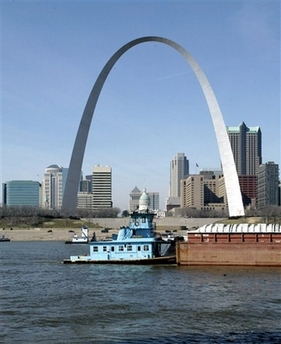ST. LOUIS - Just days after the St. Louis Cardinals won the top honor in
Major League Baseball, their hometown jumped to first place on a list no one
wants to lead: the most dangerous cities in the United States.
This Midwestern city has long been in the upper tiers of the annual ranking
of the nation's safest and most dangerous cities, compiled by Morgan Quitno
Press. Violent crime surged nearly 20 percent there from 2004 to last year, when
the rate of such crimes rose much faster in the Midwest than in the rest of
nation, according to
|

The St. Louis Gateway Arch is part of the St. Louis skyline
as a barge and tow make their way north along the Mississippi River
Wednesday, Feb. 18, 2004. Just days after the St. Louis Cardinals won the
top honor in Major League Baseball, their hometown jumped to first place
on a list no one wants to lead: the most dangerous cities in the United
States. [AP]
|
FBI figures released in June.
"It's just sad the way this city is," resident Sam Dawson said. "On the news
you hear killings, someone's been shot."
The ranking, being released Monday, came as the city was still celebrating
Friday's
World Series victory at the new Busch Stadium. St. Louis has
been spending millions of dollars on urban renewal even as the crime rate
climbs.
Mayor Francis Slay did not return calls to his office seeking comment Sunday.
Scott Morgan, president of Morgan Quitno Press, a private research and
publishing company specializing in state and city reference books, said he was
not surprised to see St. Louis top the list, since it has been among the 10 most
dangerous cities for years.
Morgan said the study looks at crime only within St. Louis city limits, with
a population of about 330,000. It doesn't take into account the suburbs in St.
Louis County, which has roughly 980,000 residents.
The safest city in 2005 was Brick, N.J., population about 78,000, followed by
Amherst, N.Y., and Mission Viejo, Calif. The second most dangerous city was
Detroit, followed by Flint, Mich., and Compton, Calif.
Cities are ranked based on more than just their crime rate, Morgan said.
Individual crimes such as rape or burglary are measured separately, compared to
national averages and then compiled to give a city its ranking. Crimes are
weighted based on their danger to people.
The national FBI figures released in June showed the murder rate in St. Louis
jumped 16 percent from 2004 to 2005, compared with 4.8 percent nationally. The
overall violent crime rate increased nearly 20 percent, compared with 2.5
percent nationally.
While crime increased in all regions last year, the 5.7 percent rise in the
12 Midwestern states was at least three times higher than any other region,
according to the FBI.
Visiting St. Louis on Thursday, FBI director Robert Mueller said it was too
early to tell why some types of crime were rising faster in the Midwest.
Mueller said the FBI is working harder to form partnerships with police
departments to launch programs like St. Louis' Safe Streets task force, which
focuses police efforts on problematic neighborhoods.
This year's ranking was good news for Camden, N.J., which in 2005 was named
the most dangerous city for the second year in a row.
Camden Mayor Gwendolyn Faison said Sunday she was thrilled to learn that her
city no longer topped the most-dangerous list.
"You made my day!" said Faison, who has served since 2000. "There's a new
hope and a new spirit."